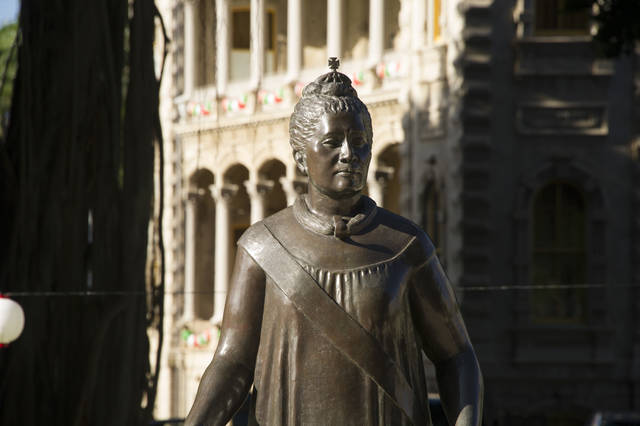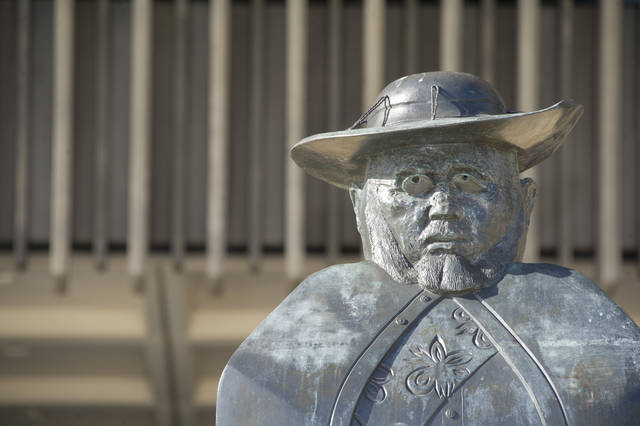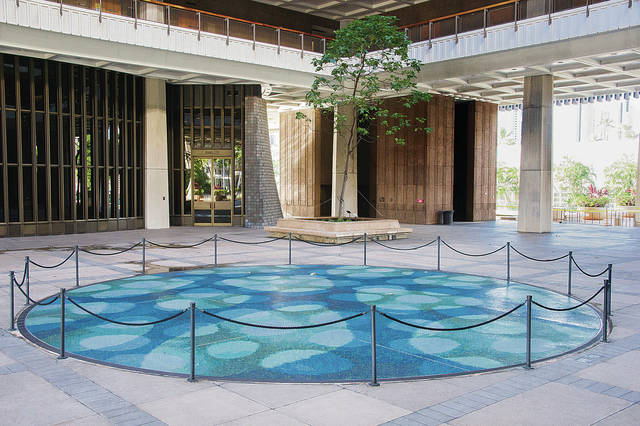State Capitol shares lessons in art, culture, history and aloha
By Cheryl Chee Tsutsumi, Honolulu Star Advertiser, January 14, 2018 Updated January 14, 2018 12:05am, photos by Craig T. Kojima (Reprinted with permission from editor.)
“The open sea, the open sky, the open doorway, open arms and open hearts — these are the symbols of our Hawaiian heritage. In this great State Capitol there are no doors at the grand entrances which open toward the mountains and toward the sea. There is no roof or dome to separate its vast inner court from the heavens and from the same eternal stars which guided the first voyagers to the primeval beauty of these shores.”
Gov. John A. Burns
At the dedication of Hawaii’s state Capitol on March 15, 1969
After nearly a decade of planning, Hawaii’s territorial and state legislatures moved from Iolani Palace, where they had convened for some 70 years, to the state Capitol building. Gov. John A. Burns wanted the structure of the Capitol to represent Hawaii’s people, history, culture and aloha.
IF YOU GO: HAWAII STATE CAPITOL TOUR
> Address: 415 S. Beretania St.
>> On the Net: Click here for more info.
>> Notes: Self-guided tour information is available online and in the governor’s office weekdays between 8:30 a.m. and 3:30 p.m. The Senate and House chambers are not accessible on self-guided tours.

The exterior of the state Capitol.
Twenty-eight architects were interviewed for the $25 million project, including I.M. Pei, whose impressive works include the glass-and-steel pyramid design at the Louvre in Paris, the John F. Kennedy Presidential Library and Museum in Massachusetts and the East-West Center at the University of Hawaii at Manoa. Ultimately, the contract was awarded to San Francisco-based John Carl Warnecke.
“Warnecke’s firm had won many awards for embassies and government buildings around the world,” said Richard Rodrigues, community relations specialist in the governor’s office, who leads several tours of the Capitol every week. “Partnered with the Honolulu firm Belt, Lemmon and Lo — which became Architects Hawaii and is now known as AHL — they gave the people of Hawaii a gift that is remarkable for its subtle but significant details.”
Surrounded by a reflecting pool symbolizing the Pacific Ocean, the Capitol was envisioned by the architects as an island formed by two volcanoes — the cone-shaped Senate and House of Representatives chambers that flank the courtyard. The eight pillars fronting the Capitol’s entrances represent the eight main Hawaiian Islands and are shaped like coconut palm trunks. Among the other places patterns of eight appear: the panels on front of the governor’s koa desk and the pillars lining the interior and exterior of the fourth floor.
Four is another repetitive design feature. It represents the state’s four counties and four major Hawaiian gods (Kukailimoku, Kane, Lono and Kanaloa). There are four kukui trees (Hawaii’s state tree) in the courtyard, four doorways to each chamber, four windows on each side of those doorways and four pillars on the interior and exterior corners of the fourth floor.
Also of note are seven works of art in the State Foundation on Culture and the Arts’ Art in Public Places collection. The program was established in 1967 with the enactment of the Art in State Buildings Law, which designated 1 percent of the construction costs of new state buildings for the acquisition of works of art, either by commission or purchase.

The Queen Lili‘uokalani statue on the Iolani Palace side of the building.
‘Spirit of Lili‘uokalani’
Queen Lili‘uokalani ruled in tumultuous times. The Hawaiian monarchy was overthrown in 1893, and in 1895, after an unsuccessful attempt to restore her to power, she was imprisoned in Iolani Palace for eight months. The larger-than-life bronze statue of the queen on the makai (ocean) side of the Capitol — the side nearest the palace — can be seen as a bridge between the monarchy and the democracy that replaced it.
DID YOU KNOW…
>> The Capitol is part of the Capital Historic District, which has been on the National Register of Historic Places since 1978. Within the district’s boundaries are 20 notable structures dating between 1825 and 1969.
>> In addition to the seven pieces spotlighted in this story, some 900 other works from the Art in Public Places collection — some by famous local artists such as Jean Charlot, Herb Kawainui Kane and D. Howard Hitchcock — are displayed in legislators’ offices. During the annual Art at the Capitol event, you can visit participating offices and vote in the “People’s Choice” competition featuring art created by legislators. This year’s event will be 4:30 to 7 p.m. April 6.
>> In the mid-1960s, after the assassination of her husband, former first lady Jacqueline Kennedy and her two children lived in Hawaii for a few months, away from the public eye. John Carl Warnecke, a good friend of the couple, invited Kennedy to tour the Capitol while it was being constructed. Known for her impeccable taste, she suggested that the ceiling in the governor’s office be raised to 15 from 10 feet to enhance the room’s feeling of grandeur. Warnecke agreed and a redesign was done.
>> The Capitol’s Public Access Room offers free services and resources, including handouts with information about Hawaii’s Legislature, broadcasts of local House and Senate proceedings and tutorials and workshops on how you can participate in the legislative process. The room is open 7:45 a.m. to 6 p.m. weekdays from January through May (when the Legislature is in session) and 8 a.m. to 4:30 p.m. May through December. Call 587-0478 or email par@capitol.hawaii.gov.
“The queen is beloved for her courage, compassion and dignity, and American realist sculptor Marianna Pineda captured those qualities in the statue’s regal stance,” Rodrigues said. “There are three documents in Lili‘uokalani’s left hand: Hawaii’s Constitution; the Kumulipo, Hawaii’s creation story; and ‘Aloha Oe,’ the most famous of the more than 150 songs and chants that she composed.
“Her right hand is outstretched, suggesting she is reaching out to her people and saying, ‘I surrendered my authority to the United States to avoid bloodshed, but I am with you. As you shape Hawaii’s future, remember its history, values and traditions.’”

The Damien statue faces Beretania Street.
St. Damien statue
French sculptor Marisol Escobar created the bronze statue of St. Joseph Damien de Veuster that stands on the mauka (mountain) side of the Capitol. For 16 years Damien ministered to people suffering from Hansen’s disease in the remote settlement of Kalaupapa, Molokai. He contracted the disease and died from it in 1889 at the age of 49.
“There was some controversy surrounding Marisol’s interpretation of Damien because rather than showing him as a young man, she depicted him later in life,” Rodrigues said. “You see his disfigured face and his crippled hand holding a cane. It’s a powerful image that portrays the huge sacrifices he made to his life’s work. The statue is so heavy, it needed to be placed exactly where it is, so it could be supported by a concrete pillar in the Capitol’s underground parking garage.”
A second casting of Escobar’s statue stands in the National Statuary Hall at the U.S. Capitol (the other statue representing Hawaii in Washington, D.C., is of King Kamehameha).

A view of the courtyard with “Aquarius,” the tile mosaic designed by artist Tadashi Sato.
‘Aquarius’
“Aquarius,” the 36-by-36-foot mosaic on the courtyard’s floor, is made of 600,000 ceramic tiles that are no bigger than a fingernail. It’s a replica of a painting by Tadashi Sato, who was born and raised on Maui.
“Tadashi’s parents were Japanese immigrants and he grew up poor,” Rodrigues said. “Because he didn’t have much money for fun, he would spend a lot of his free time at the ocean, which inspired most of his work.”
Five hundred different colors of tile were used for “Aquarius.” The best place to view the mosaic is from the upper floors. “You look down and see sunlight sparkling on blue-green water,” Rodrigues said. “Little lines flashing in different places could be fish. I also see a whale’s tail, turtles, manta rays and an iwa (frigate bird) with its wings stretched wide. The more you look at ‘Aquarius,’ the more you imagine.”
Tapestries and chandeliers
It took 16 weavers three years to complete each 40-foot tapestry that hangs in the Senate and House of Representatives chambers. Textile artist Ruthadell Anderson, a Manoa resident who’s now in her late 90s, designed them and supervised the work, which was done in a Kakaako warehouse.
“The tapestry in the Senate is in the cool colors of the ocean, sand and sky,” Rodrigues said. “The tapestry in the House is in warm earth tones. Neither tapestry has a name and they’re abstracts. Ruthadell didn’t provide explanations; she intended viewers to interpret them in their own way. I see a poi pounder, a pineapple, sugar cane stalks and a shark tooth weapon in the House’s tapestry. Canoes, clouds, waves and sea creatures are some of the images that come to my mind when I look at the Senate’s tapestry.”
Otto Piene, a native of Germany, created a kinetic light sculpture for each chamber. In the House the Sun chandelier comprises dozens of gold-plated globes; in the Senate the Moon chandelier flaunts 620 perfectly matched white chambered nautilus shells.
Gov. Burns’ pride in the Capitol was obvious as he delivered his address on opening day: “It is by means of the striking architecture of this new structure that Hawaii cries out to the nations of the Pacific and of the world, this message: We welcome all visitors to our island home. We invite all to watch our legislative deliberations, to study our administrative affairs, to see the examples of racial brotherhood in our rich cultures. … E komo mai! Come in! The house is yours!”
Cheryl Chee Tsutsumi is a Honolulu-based freelance writer whose travel features for the Star-Advertiser have won several Society of American Travel Writers awards.


